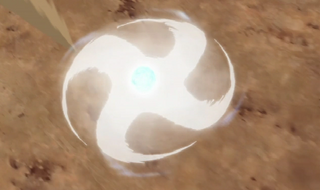|
|
| editWind Release: Rasenshuriken | |||
|---|---|---|---|
 | |||
| Name | |||
| Kanji | 風遁・螺旋手裏剣 | ||
| Rōmaji | Fūton: Rasenshuriken | ||
| Literal English | Wind Release: Spiraling Shuriken | ||
| English anime | Wind Style: Rasenshuriken | ||
| Debut | |||
| Appears in | Anime, Manga | ||
| Data | |||
| Classification | Ninjutsu, Wind Release | ||
| Rank | S-rank | ||
| Class | Offensive | ||
| Range | All ranges | ||
| Other jutsu | |||
| Parent jutsu | |||
| |||
| |||
The Wind Release: Rasenshuriken is a variation of the Wind Release: Rasengan, similar to the Great Ball Rasengan being a variation of the standard Rasengan. Naruto used this jutsu to defeat Kakuzu of the Akatsuki, destroying two of Kakuzu's hearts. By manipulating the wind chakra of the Wind Release: Rasengan, Naruto was able to create four large points, making the Rasengan appear as a giant shuriken, the Rasengan in the center remaining a perfect sphere. The technique gives off a loud bell-like screech and is so powerful that it creates a storm around the area. Despite the name, because the Rasengan is a hand held jutsu, the Rasenshuriken can not be thrown, a problem that caused Choji Akimichi to question the jutsu. Instead, Naruto has to figure out a way to get close enough to his opponent and hit them. If it is successful, the victim becomes trapped in a vortex of wind chakra blades that attack the body on a cellular level so many times that even a fully mature Sharingan cannot count the number of wind slices. The wind chakra severs the chakra and nerve channels in the body. The Rasenshuriken is a vastly dangerous and powerful jutsu.
Drawbacks
The main drawback of the Rasenshuriken is that it is a double-edged sword. While it can utterly devastates any opponent trapped in the vortex, it also greatly damages the user's body. When Naruto used the Rasenshuriken twice on Kakuzu, it caused Naruto limited cellular damage and a few broken bones. The Fifth Hokage has hence decreed the Rasenshuriken as a Kinjutsu, forbidding it as it could cause Naruto to be unable to mold chakra at all and possibly causing paralysis if important bones or organs were fractured. It should be noted that Naruto has not yet been revealed to have completed the Wind Release: Rasengan, only being about half complete according to Yamato. Naruto was later able to refine the Rasenshuriken while training in Hermit Mode; while revealing it in his fight against Pain, he was able to throw the Rasenshuriken, thus preventing any damage from the jutsu to his own body. Furthermore, the Rasenshuriken now expands a short while after being thrown thus increasing its radius of attack. However, this technique seems to tire out Naruto easily, as Pain commented on how his natural chakra levels decreased drastically after the usage of the jutsu.
Other Users' Usages
Lastly, Koga Tensei showed use of this move after trying to mimic his hero, Naruto's own Rasenshuriken. Koga's version is much smaller than Naruto's and he cannot easily control the direction of the jutsu, making it's path very unpredictable. Junsui Kirei, Koga's teacher, once said that these two things alone take the Rasenshuriken that Koga uses back down to an A-rank, showing how much weaker Koga's version is. Koga uses his Nine-Tailed Demon Fox chakra to create his Rasenshuriken, allowing him to use it four time per day.
Hideki Uchiha, displayed this technique after using his Sharingan to discover the Mechanics of this technique, and eventually copy it. However his is much weaker than Naruto's own Rasenshuriken, mainly because he is not a Jinchuriki, therefore he cannot use the Nine-Tailed Demon Fox chakra to create the technique. Hideki, however can control where the technique goes, and how far it expands, leaving the technique a S-Rank technique

